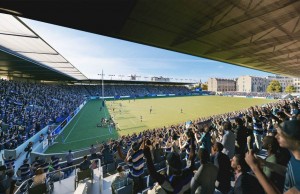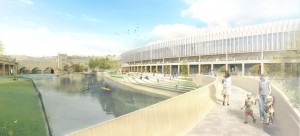The redeveloped Rec will not only be one of the best places in the world to watch rugby but also a catalyst for change in a “divided city”, the chief executive of Bath Rugby has claimed.
With the long-awaited project due to be submitted for planning consent early next year, Tarquin McDonald has spoken about the challenges of redeveloping a stadium in a world heritage city and how it will play a wider role in addressing some of Bath’s social issues. 
The key feature of the Stadium For Bath scheme – which brings together Bath Rugby, Bath Rugby Foundation and stadium developer Arena 1865 – is to increase the capacity of The Rec from 14,500 to 18,000 by creating a modern sporting arena that will have “an imposing, gladiatorial atmosphere”.
Increased hospitality space on match days, car parking and a restaurant, café and new club shop will bring in revenue for the club.
But Mr McDonald said the redevelopment was about “much more than just Bath Rugby”. The club is viewing it as a civic project that will harness the “unique power of sport to bring about social change”, he said.
“It’s a stadium for Bath – a place for everybody in the city, whether they like rugby or not,” he said.
“Bath is a city built on ambition. Seven million visitors come here a year. But it is also a city with challenges. There is 20% child poverty in the city – 40% in some areas. A child, born in Bear Flat can expect to live for nine-and-a-half years longer than a child born in Twerton.
“So this is a unique opportunity for us on the pitch but also off it. A successful sports team is more than the sum of its parts but Bath as a city is less than the sum of its parts.”
Sport could play a role in bringing people together and overcoming social barriers, he said.
“On the pitch we have connection and belief and oneness. We want that for the wider city.”
The timing of the scheme also meant it would form part of a new era for Bath which will include the first major new office development for a generation at Bath Quays and new housing on Western Riverside.
“We are proud to be part of the new Bath based on live, work and play,” Mr McDonald said.
While redevelopment of The Rec has been talked about for around 35 years, the current scheme began to be worked on in 2017 when the legal issue around ownership of the site was resolved. 
Mr McDonald said there were unique challenges for the project, pointing out that nobody has ever developed a new stadium in a world heritage city before.
Apart from that, the site is owned by a charity – Bath Recreation Ltd – is on a flood plain and it is surrounded by Grade I listed buildings.
Stadium For Bath had consulted widely, talking to or meeting organisations as diverse as UNESCO, the Georgian Society and local residents groups, he said.
The physical elements of the proposals include plans for the regeneration of the riverside between North Parade and Pulteney Bridge with a restaurant, café, club shop and area that can be used for local artisan food retailers and for entertainment and public art.
The Rec’s pitch will be raised to greatly minimise the flood risk while it will also be relayed with a new harder-wearing playing surface similar to that used at Wembley – meaning it can be used for community sport on non-match days.
Stadium For Bath is working with London-based architecture practice Grimshaw, which was responsible for the re-designed Wimbledon No 1 Court and grandstand at Lord’s cricket ground, on the redesign.
“There are a lot of great architects and we went through a rigorous selection process,” said Mr McDonald. “Grimshaw absolutely understood our vision – to combine the club’s vision with the city’s needs.
“The stadium will look good from the outside – most don’t. All the effort is making them look good on the inside – but from outside they often look like you’re approaching them from the back.”
Grimshaw’s design is to look at the scheme as three ‘rooms’ in the context of the location – The River, The Cauldron and The Rec.
“The Cauldron will build on what The Rec is famous for – intimacy. Also working with (Bath-based international civil engineering group) Buro Happold on maximising the experience to give it an imposing, gladiatorial atmosphere,” said Mr McDonald.
“We are working on the acoustics to maximise the sound inside the ground and minimise it outside.”
He said the riverside part of the plan would help overcome the fact that Bath has long turned its back on the river.
“Look at what’s happened in other cities, places like London’s South Bank. This is a brilliant opportunity to deliver positive change in Bath.”
The plans include a 50,000 sq ft riverside park and plaza, making it a welcoming place for everyone. “It will be the engine of the scheme – a civic space with public art,” he said.
A new East Stand will include a suite of classrooms for up to 200 young adults and teenagers who are not in education, employment or training.
“80% of children in Bath are among the best educated in the country,” he said. “But 20% are among the worst.”
Having educational facilities in the stadium meant the students can easily use the pitch for sports – not just rugby – alongside classroom-based learning.
Hospitality suites used on matchdays will double up a chefs’ academy for young people to gain qualifications. Those launching their own food businesses could go on to sell their produce from the riverside food stalls.
Some 3,000 sq ft of space in the East Stand will be given over to charities and not-for-profit organisations that cannot afford city centre rents. There will also be space to support sporting participation and wellness projects jointly with Bath & North East Somerset Council.
The planning application is expected to be submitted to the council early next year, possibly in February. If approval is received, work on the regeneration would be likely to start during the 2020/21 season – meaning the club will have to relocate for the duration of the season.
Talks are already taking place with other stadia on a ground-sharing basis, Mr McDonald said.
No official cost has been put in the project by Stadium For Bath, although it is understood to be above £30m.



















